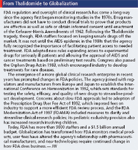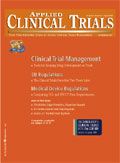FDA to Modernize BIMO Activities
Applied Clinical Trials
Agency seeks to calm critics by improving subject protection, while also streamlining research oversight.
As the Food and Drug Administration celebrated its 100th birthday in June, it unveiled a major initiative for overhauling how it regulates clinical trials and protects participants in research studies. In outlining the plan for the Human Subject Protection and Bioresearch Monitoring (HSP/BIMO) initiative at the annual meeting of the Drug Information Association (DIA), Deputy Commissioner for Operations Janet Woodcock noted that it reflects the emergence of an "increasingly large, decentralized, and global" research enterprise. She cited the need to respond to dramatic changes in the nature and conduct of clinical research characterized by:

Jill Wechsler
- a steady increase in the number of clinical trial studies and sites in the United States and abroad
- larger trials involving many small, individual sites
- proliferation of different electronic record-keeping methods and systems for data collection and processing
- more complex trial methods and designs
- greater participation of vulnerable subjects, including children
- increased use of contract research organizations (CROs) to manage studies
- more variation in institutional review board (IRB) structure, including centralized, free-standing, and for-profit entities
- increase in human specimens, requiring new policies for storage and handling
- more studies involving complex medical devices and combination products.
Woodcock regards this undertaking as an important component of the Critical Path Initiative, which highlights the need to streamline and improve clinical research processes. By taking steps to safeguard study participants and ensure that trials produce high-quality data, FDA also hopes to bolster public confidence in research activities and stem criticism of lax FDA enforcement. Some observers have raised concerns that increased commercialization of human subject research has fostered unethical recruitment practices, particularly in foreign trials. And allegations of research fraud related to clinical studies for Sanofi-Aventis' antibiotic Ketek (telithromycin) have raised questions about FDA's research monitoring program.
Seeking coordination
FDA first began inspecting clinical trial sites in the 1970s, primarily to verify the accuracy and integrity of investigator data (see sidebar "From Thalidomide to Globalization"). The importance of also protecting the rights and safety of research subjects became more visible in the 1980s, following publication of the Belmont Report in 1979 and subsequent adoption of the "Common Rule" by the Department of Health and Human Services and other federal agencies. That policy requires researchers to obtain and document informed consent; provides special protections for children, women, and prisoners; and sets policies for institutional review boards (IRBs) to oversee research proposals and operations.

From Thalidomide to Globalization
The need to monitor a growing clinical research enterprise has generated different bioresearch monitoring (BIMO) programs in each FDA Center. This has created a highly decentralized system and a variety of compliance programs for field inspectors to follow when auditing investigators, sponsors, CROs, and IRBs. Now, the agency seeks to modernize and better coordinate this program, noting a lack of resources to inspect every research site and a continued reliance on a paper-based system in an automated world.
Over the past year, Woodcock and agency staffers have been assessing BIMO programs and identifying opportunities for improvement. She notes a lack of databases and electronic information systems, as well as too few guidances for implementing good clinical practices.
The announcement of the BIMO initiative was not news to many agency observers, as FDA has been discussing these problems during the past year while moving forward with a number of changes in research policies and practices. The agency has issued guidances on using centralized IRBs to oversee multicenter clinical trials and for establishing Data Monitoring Committees to better ensure subject safety. Several information sheets for the research community were published at the beginning of this year, and a new draft guidance involving safeguards for children in clinical trials was published in May 2006.
FDA recently published a new rule extending waivers of informed consent for emergency research in the case of public health emergencies and exposure to life-threatening agents. The Center for Devices and Radiological Health (CDRH) also issued a draft guidance clarifying time frames and processes for conducting BIMO inspections of research sites providing data to support premarket applications for important medical devices.
Now, a formal HSP/BIMO steering committee will oversee these multiple activities. Woodcock chairs the group, which includes representatives from centers for biologics, drugs, food, medical devices, and veterinary medicine, plus the Office of Regulatory Affairs and the Good Clinical Practice Program in the Commissioner's office, headed by David Lepay.
The committee has a full agenda. A main goal is to revise FDA's internal governance of BIMO programs across centers to establish a more unified approach. In addition to finalizing draft policies, it plans to complete a promised guidance on how IRBs can deal with the overwhelming volume of adverse event reports they now receive, an issue addressed at an FDA public hearing in March 2005. Another item is to finalize a proposed rule for ensuring that sponsors maintain ethical standards in foreign clinical studies not conducted under IND rules.
The panel also will weigh several new initiatives:
- whether to extend FDA's current regulations to cover subinvestigators and subcontractors that do not fall under the agency's current rules governing sponsors and principle investigators
- a new policy to encourage sponsors to uncover and report cases of data falsification by investigations
- revisions in rules on treatment INDs and charging for drugs under INDs to clarify current regulations and help spur innovative research.
Seeking standards
Another priority is to improve the quality of clinical research data by promoting electronic data collection and submission. To this end, FDA is supporting a collaborative effort to develop clinical data standards for case report forms (CRFs). Woodcock announced at the DIA conference a new collaboration headed by the Clinical Data Interchange Standards Consortiums (CDISC) and the Association of Clinical Research Organizations (ACRO). Representatives of industry, academia, IT vendors, and FDA discussed this issue at a meeting last January (2006) and now hope to launch a number of projects to test and define standards for automatically generating electronic CRFs.
FDA also plans to finalize a guidance on utilizing computerized systems in clinical trials. And it is working with HHS' Office of Human Research Protections (OHRP) to establish a central IRB registry, which will provide a database on IRB activity that can help coordinate agency oversight of these panels. Woodcock expects to issue a more formal steering committee work plan in the next few months.
Jill Wechsler is the Washington editor of Applied Clinical Trials, (301) 656-4634 jwechsler@advanstar.com

FDA Fast Tracks Johnson & Johnson’s Nipocalimab for Fetal Neonatal Alloimmune Thrombocytopenia
March 27th 2024Johnson & Johnson is moving forward with a pair of Phase III trials of nipocalimab to reduce the risk of fetal neonatal alloimmune thrombocytopenia in alloimmunized pregnant patients.